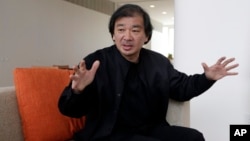WASHINGTON —
For the third year in a row, an Asian architect will receive the prestigious Pritzker Prize. Japanese architect Shigeru Ban is the latest recipient of the award, which is considered to be the profession’s “Nobel Prize.” He will receive the prize at a ceremony at the Rijksmuseum in Amsterdam on Friday.
“Since I spent three years on the jury, between 2006 and 2009, I didn’t expect I would be chosen, so it’s a big surprise for me,” he said. “Compared to past laureates, I didn’t think I reached that level yet.”
Born in Tokyo, the 56-year-old Ban is known for his humanitarian structures, as well as his formal architecture. In 1994, he built relief shelters in Rwanda following that country’s civil war and genocide. The next year, he helped the Japanese city of Kobe after the Great Hanshin Earthquake.
“For me, there is no difference between the normal architecture project and the humanitarian activities,” he said. “It’s just a different budget and a different atmosphere, and also there is no design fee but otherwise there’s no difference.”
Ban believes architecture should embrace all of society and not just the elite.
“After I became an architect I was quite disappointed in my profession because mostly we are working for privileged people who have the power and money,” he said. “I’m interested in making monuments, but I thought we can use our experience and knowledge for the general public, even for the people who lost their houses through natural disasters.”
Ban’s career has been notable also for its use of basic materials such as paper and plastic crates. He began his career in 1986, after studying in the United States at the Southern California Institute of Architecture and the Cooper Union School of Architecture. Ban started out in Japan by using paper tubes to construct designs as a way to reduce project costs. His methods were initially questioned by skeptical Japanese officials.
“First I had to get permission from the government to use the material as a structure element,” Ban said. “And also at that time, in 1986, nobody was talking about ecology or recycling, so it was quite unusual to use this for building, but now because everyone is interested in environmental issues, it’s become much easier to convince people.”
The paper used is industrial material and can be waterproofed and fire-protected. Some of Ban’s most prominent designs, including the Paper Church built for Kobe, Japan (later moved to Taiwan), and the Cardboard Cathedral in Christchurch, New Zealand, are built of paper materials. Both were constructed following devastating earthquakes.
The Pritzker jury also cited the Naked House in Saitama, Japan for questioning “the traditional notion of rooms and consequently domestic life.” Another Ban trademark is his melding of exterior and interior spaces, as shown in the Curtain Wall House in Tokyo.
Ban is an international architect with buildings in Europe, Asia and the U.S. He has offices in Tokyo, Paris and New York. Two other Asian architects, Wang Shu of China and Toyo Ito of Japan, won the Pritzker Prize in 2012 and 2013.
“Since I spent three years on the jury, between 2006 and 2009, I didn’t expect I would be chosen, so it’s a big surprise for me,” he said. “Compared to past laureates, I didn’t think I reached that level yet.”
Born in Tokyo, the 56-year-old Ban is known for his humanitarian structures, as well as his formal architecture. In 1994, he built relief shelters in Rwanda following that country’s civil war and genocide. The next year, he helped the Japanese city of Kobe after the Great Hanshin Earthquake.
“For me, there is no difference between the normal architecture project and the humanitarian activities,” he said. “It’s just a different budget and a different atmosphere, and also there is no design fee but otherwise there’s no difference.”
Ban believes architecture should embrace all of society and not just the elite.
“After I became an architect I was quite disappointed in my profession because mostly we are working for privileged people who have the power and money,” he said. “I’m interested in making monuments, but I thought we can use our experience and knowledge for the general public, even for the people who lost their houses through natural disasters.”
Ban’s career has been notable also for its use of basic materials such as paper and plastic crates. He began his career in 1986, after studying in the United States at the Southern California Institute of Architecture and the Cooper Union School of Architecture. Ban started out in Japan by using paper tubes to construct designs as a way to reduce project costs. His methods were initially questioned by skeptical Japanese officials.
“First I had to get permission from the government to use the material as a structure element,” Ban said. “And also at that time, in 1986, nobody was talking about ecology or recycling, so it was quite unusual to use this for building, but now because everyone is interested in environmental issues, it’s become much easier to convince people.”
The paper used is industrial material and can be waterproofed and fire-protected. Some of Ban’s most prominent designs, including the Paper Church built for Kobe, Japan (later moved to Taiwan), and the Cardboard Cathedral in Christchurch, New Zealand, are built of paper materials. Both were constructed following devastating earthquakes.
The Pritzker jury also cited the Naked House in Saitama, Japan for questioning “the traditional notion of rooms and consequently domestic life.” Another Ban trademark is his melding of exterior and interior spaces, as shown in the Curtain Wall House in Tokyo.
Ban is an international architect with buildings in Europe, Asia and the U.S. He has offices in Tokyo, Paris and New York. Two other Asian architects, Wang Shu of China and Toyo Ito of Japan, won the Pritzker Prize in 2012 and 2013.









